how to grow carrots, with dr. john navazio
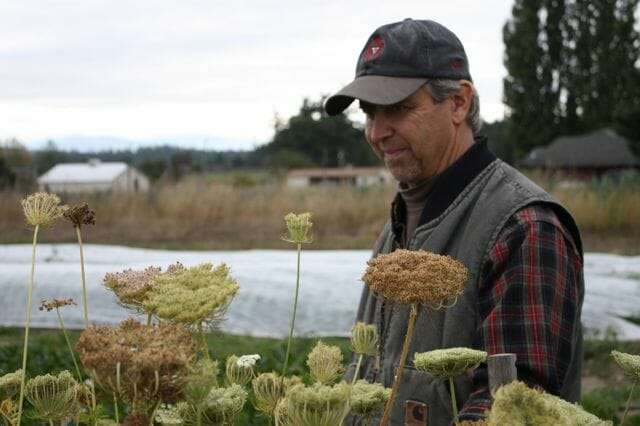 WHEN THE MOST COMMON CHALLENGE readers confessed in a recent story on vegetable gardening was “I can’t grow carrots,” I knew who to call: John Navazio, Ph.D. to the rescue. John, who at the time served in a joint role as Senior Scientist for the Organic Seed Alliance and the Washington State University Extension specialist for organic seed for his home state, has grown—and bred—more than a few carrots in his time.
WHEN THE MOST COMMON CHALLENGE readers confessed in a recent story on vegetable gardening was “I can’t grow carrots,” I knew who to call: John Navazio, Ph.D. to the rescue. John, who at the time served in a joint role as Senior Scientist for the Organic Seed Alliance and the Washington State University Extension specialist for organic seed for his home state, has grown—and bred—more than a few carrots in his time.
John, whose dramatic and delicious purple ‘Dragon’ carrot is bright orange inside, was reassuring as ever. First, don’t feel bad, he said. “Carrots are one of the harder vegetables to grow,” confirms John (with flowering carrots in an OSA photo, above), and for a few reasons:
They’re such small plants when they first sprout (the seed isn’t too big, either; I like to use pelleted, shown below, and there are now pelleted ones that meet organic certification requirements).
To get really good quality you need “unchecked growth”—no obstacles either literal (like rocky or otherwise tough soil) or meteorological (extremes of heat, cold or especially dryness). “Succulence and flavor will suffer if the growth is checked,” John explains–and so can their shape.
Would that we all were surrounded by a true loam (meaning an ideal soil with equal parts sand, silt and clay)—but since we’re generally not, the answer, John says: compost.
“Adding lots of organic matter—not bagged products, but high-quality local compost in bulk—will help you grow good carrots, and it will also help solve problems many gardeners have growing broccoli, cabbage and Brussels sprouts to good size,” says John, who later served as manager of plant breeding at Johnny’s Selected Seeds in Maine. (Update: The seed world lost one of its real heroes when John died in June 2024.)
john’s carrot how-to:
- Plant your root crops, including carrots, in the least-rocky soil you have.
- The soil should have a good “tilth”—with plenty of organic matter in the form of compost incorporated.
- Plant early, but not too early. A 70-80F degree soil temperature is ideal, but if you are patient, and don’t mind slower germination, plant in spring once soil temps are consistently above 60F, or as the old-timers would say “once the weather has settled.” (Many gardeners stagger sowings to have fresh-eating carrots over a longer season, timing their “storage” types to harvest late.)
- Don’t overwork the soil; a fine powder (which can result from mechanical tilling) can crust over—and crusting=checked growth=bad news. Just work the soil enough to create a welcoming seedbed.
- Plant the seed ½ inch deep and don’t sow too thickly! Better to space correctly than to thin. “I’m a great believer in putting down the exact amount you need—not too little, and not three to five times too much!” John advises.
- Assuming you are using fresh seed or a leftover packet that has been properly stored, germination would be about 80 percent, so:
- “Take your time, and carefully place 16-20 seeds per foot in the row,” John says. If you have good seed, you’ll be ‘planting to stand,’ as farmers say—plant right, and you eliminate thinning time.” The successful plants will end up about an inch apart.
- Alternatively: Plant staggered in 2½- to 3-inch-wide “bands.”
- Gently tamp down the seedbed once sown; don’t step on it, be gentle.
- Be prepared to wait 7-10 days for germination.
- Keep the seedbed evenly moist till the seeds emerge. Especially in clayey soils, crusting must be prevented or else!
- Make light, frequent sprinklings to a depth of 2-3 inches. If the seed’s tiny radicle—the embryo’s primary root—meets resistance? Death, says John.
- A trick to “mulch” the seedbed: “Sprinkle a very light layer of grass clippings on top of the row to keep things moist,” he says.
- Or the tip John likes best: Sow radish or even better turnip seed among the carrots. Both germinate extra-fast, and help break through any possible crust.—and also mark the row, since they sprout before the carrots. “Pick the tiny plants and eat the baby leaves in salad,” he advises.
- If you planted too thickly and must thin (like the seedling below), do so in the first couple of weeks after emergence.
- Weeding is essential—early and often; ferny-textured carrot foliage isn’t much competition for weeds. Hand weed; don’t let any competition get established.
- Remember our mantra throughout the growth cycle: unchecked growth. The taproot of the carrot is below the carrot itself–meaning what John calls the “buggy whip” (like the one in the photo above), which can be 14-18 inches long, needs water. Soak deeply as the plants grow.
 when are they ready to harvest?
when are they ready to harvest?
DON’T JUDGE a carrot by its seed packet’s days-to-harvest number. Catalog and labels may say 65-70 days for many varieties, but “that is not my experience,” says John. “They can take 95-100ish even.” How to tell? Pull a few to see if you’ve got “tip fill” yet–at least some degree of blunting at the end, and also to taste for full development of flavor. You can eat them sooner, of course, but why waste a mouthful?
which carrots to grow?
FOR THOSE who have had trouble growing carrots, John recommends a couple of sturdy but delicious varieties to get you started:
- ‘Paris Market‘ types (the early, fat, rounded little guys), or ‘Oxheart’ or ‘Atlas’ don’t develop deep roots, so these should boost your confidence.
- ‘Red Core Chantenay,’ with big shoulders, need somewhat deeper soil, but are strong growers. “They can get as big as a coffee mug around and 10 inches long,” John says. “They’re great for cooking–those are the diced carrots in every can of soup.” While delicious, Nantes types (cylindrical like a cigar, not tapered) prefer better soils. They have wonderful fresh-eating flavor, so get out the compost and go for it. John recommends ‘Scarlet Nantes’ in particular.
“I’ve put a lot of thought into how to build a better carrot,” says John, who later in his breeding career set his sights set on breeding carrots with strong, vigorous tops that will outcompete weeds more successfully. “That will be a really key breakthrough for organic agriculture.”
about the organic seed alliance
THE ORGANIC SEED ALLIANCE, a nonprofit started 10 years ago, “advances the ethical development and stewardship of the genetic resources of agricultural seed” through education, advisory services, and research programs with organic farmers and other seed professionals. In his role there, John Navazio strives to foster regional seed independence through participatory breeding projects with farmers, aiming for what he calls “farmer-centric seed systems” that select for germplasm well-adapted to each particular area.
The OSA blog is a great place to keep up to date on developments in the politics, and science, affecting our seed supply; the “advocacy” section of the OSA site suggests tactics for expressing feedback to government agencies and others about developments (such as transgenic/GMO sugar beets) that threaten our organic seed resources.
You may recall I shouted them out last year in a story about why I purchase organic seed when available.
John’s book, “The Organic Seed Grower: A Farmer’s Guide to Vegetable Seed Production,” was published by Chelsea Green in August 2012.


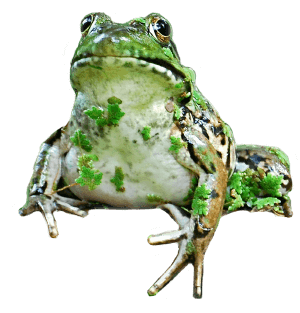
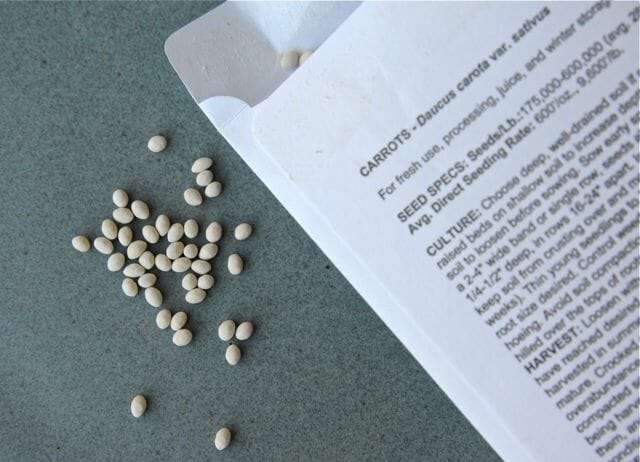
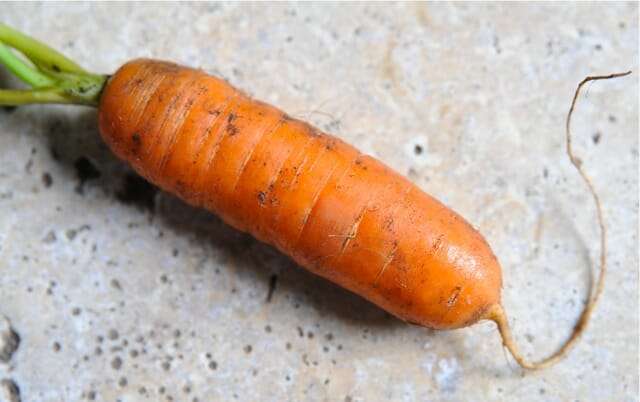
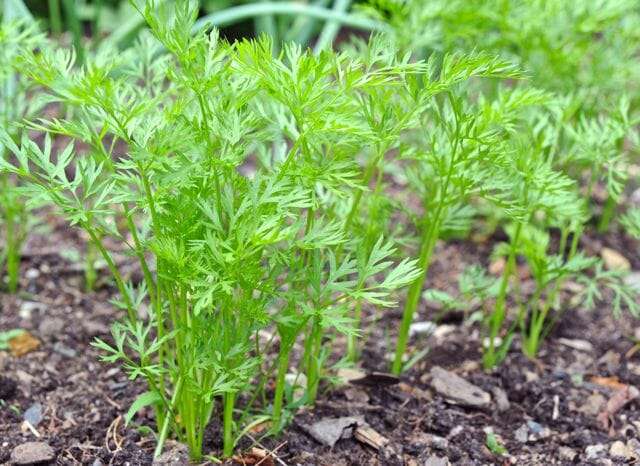


Great article. Here in western washington, it’s rare to reach a soil temperature of 80F at any time consistently. more-so we worry about wetness, if the soil is dry enough and workable in early March, then you can plant carrots, even if the average air temperature is between 40 and 50F. Raised beds are the best for making sure your soil is rock-free and your drainage is good. The worst is putting in all the effort only to have your veg or seed rot in wet soil.
The other challenge I have faced is slugs, they chew holes right into the tops and the drill through the cores of your carrots until they’re ruined. My ducks won’t eat the carrot greens, though, so I let them do a good sweeping of the carrot patch each day and it reduces slug damage.
Love the ducks versus slugs tactic, Soulstice Gardens, and welcome!
This is a great article! I’ve had years with great carrot growth, and other years where it seemed my seeds barely germinated. Looking back, the better crops were ones where I took my time and planted carefully instead of pouring a row of seeds too thickly and expecting them to thrive, based on results from years where I’ve been more meticulous.
I actually didn’t realize carrots were considered a challenge, and so now I feel more confident that it’s me – not the seed – that is the issue. I had assumed in poorer years that the seed was probably of lesser quality (being heirloom seed).
This year I have four carrot varieties going in my garden: Parisienne (a first time for me), Amarillo (my favorite), purple Dragon, and Berlicum 2 (first time for these, also). I had planned on four rows of carrots in my 4×9 raised bed, but the onions took up more room that I anticipated, and I need to leave room for at least two rows of beets, down from the three I initially planned.
We always plant carrots and didn’t really pay much attention to some of
the instructions but today bought some carrot seeds and there was a
notation” do not plant next to dill”. Why? Thank you.
Hi, Edward. It’s part of the general theory of “companion planting” (or what make bad companions, in this case). Dill and carrots are traditionally listed as bad garden companions. Some people swear by companion planting, others say many of the recommendations are “old wive’s tales”.
I’m going to have to remember this next spring. We had one carrot survive. Probably too much shade and too closed together.
Should I add sand to soil that I will grow carrots in?
Hi, Judy. You want a loose, well-drained soil so the roots can develop unimpeded. I just use a lot of compost (adding more each year) in mine, and didn’t add sand, but I didn’t start with a heavy, clayey soil or anything. I am a believer in compost, compost, compost.
Is there a difference between the planting dates of regular main-season eat-fresh carrots and fall storage carrots? I’m growing both types this year, and wondering if I should delay sowing the storage carrots?
Western WA, USDA zone 7b
Hi, Susan. Not sure if this is precisely where you live, but you will get the idea from this detailed chart. You select a variety meant for storage (not all are!) and then see how many days it takes to mature (can be 65 or 75 or 85 even) and count back from desired harvest-storage date…plus add a week or so because things grow more slowly later in the season. You might plant sometime in July for storage carrots, versus much earlier for fresh-eating varieties.
New to me last year was “Purple Haze”. It’s a beauty and delicious! It was the only carrot in the bed that ended up with straight and perfect form. I also planted YaYa, Scarlet Nantes, and Scarlet Keeper.
In dry southwestern Idaho I have heavy alkaline soil so my beds get a lot of compost every spring and most of my garden thrives. For the best carrot germination and early growth I plant seed thinly in wide bands then cover the bed with a burlap or light canvas sack and water well. I keep the fabric watered lightly before it completely dries out–no soaking. After about a week I peek to check germination; when about 75% have sprouted I uncover the row and lay chicken wire lightly over the top–mainly to keep dogs/cats from disturbing the seedlings. I thin as soon as each carrot is distinguishable and keep thinning until the plants are spaced correctly. Scarlet Nantes carrot is my favorite but I generally try to plant 3-4 varieties to be sure of a successful crop. Plus I succession plant until late July. I’ve had good luck with leaving some carrots to overwinter in the garden by mulching heavily with glass clippings and leaves then digging as needed.
I bet this year (when we had almost no winter) I could have enjoyed nonstop carrots, too, Helen. Thanks for saying hello.
Thanks All and Helen I’m going to try your burlap method since my carrot bed is a mat of weeds at this point. I weeded it but I’m afraid I may have disturbed the carrots in the process. We’ll see. Thanks all. I’m an old time gardener but carrots are a new crop for me. I made my own seed tapes of Scarlet Nantes and planted in furrows in my raised bed of compost, vermiculite and peat moss (Mel’s mix). I’m hopeful some will be successful!
Such a wreck atm, my hubby mowed over my carrots!!! The greens were 4 to 5 inches off the ground… This is my 1st time trying carrots… And since the Greens are gone I’m guessing there is no hope for the growth of the carrot!?? Your thoughts plz!?
I’d resow asap…better safe than sorry.
For Grow Carrot:
Fluff up the soil and remove debris, twigs, and rocks. You can use minimal fertilizers because carrots do not do well in fertilizer rich soils.
Space the seeds around 1 inch apart and the rows about 2 inches apart. These will give the carrots space to nourish as they grow. The seeds are tiny and sometimes they may be closer than recommended. Wait until they are 3 inches tall then space them. You can uproot those that do not meet the spacing recommendation.
Hi. I love carrots, have raised beds, rotate the crop between three gardens, and for the past three years, the carrots emerge and then disappear. When I finally do get them to grow, they are great but it takes at least three plantings. Help!
Gosh, hurry spring….I need to try growing carrots thks year!
Hi, I’m new here. . but, When reading about carrots I wonder (often!) why people don’t talk about the wonderful taste of carrot tops and how they can be prepared to eat. Why waste good vitamins and minerals!?
They have in recent years been recommended as an ingredient for pesto, for instance, yes. A very intense flavor!